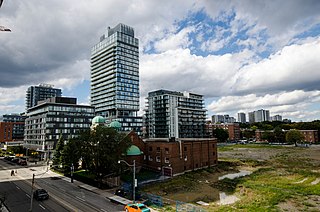Municipal elections were held in Toronto , Ontario, Canada, on January 1, 1947. With little serious opposition Robert Hood Saunders was re-elected as mayor.

Toronto is the provincial capital of Ontario and the most populous city in Canada, with a population of 2,731,571 in 2016. Current to 2016, the Toronto census metropolitan area (CMA), of which the majority is within the Greater Toronto Area (GTA), held a population of 5,928,040, making it Canada's most populous CMA. Toronto is the anchor of an urban agglomeration, known as the Golden Horseshoe in Southern Ontario, located on the northwestern shore of Lake Ontario. A global city, Toronto is a centre of business, finance, arts, and culture, and is recognized as one of the most multicultural and cosmopolitan cities in the world.

Robert Hood Saunders, Q.C., CBE was mayor of Toronto from 1945 to 1948, President of the Canadian National Exhibition, chairman of the Ontario Hydro. He was also a member of the Orange Order in Canada.
Contents
The election was a major defeat for the communist Labor-Progressive Party faction on city council, with Controller Stewart Smith and Alderman Dewar Ferguson being defeated. This left the party with only two seats on city council, Norman Freed and Charles Sims. This was somewhat mitigated by two communists winning seats on the Toronto Board of Education.
The Labor-Progressive Party was a legal political organization in Canada between 1943 and 1959.

Stewart Smith was a long-time leading member of the Communist Party of Canada. He also served on Toronto City Council for a period in the 1930s and 1940s.
The vote also featured three referendums. Two were approved that would have a lasting effect on the city of Toronto. One called for the creation of the Regent Park housing project in the east end of the city. The second approved the city buying up the land northwest of the intersection of Bay and Queen streets for a city square and municipal buildings. This would later be the site of Nathan Phillips Square and Toronto City Hall. Rejected for a third time was a proposal to move to three year municipal terms.

Regent Park is a neighbourhood located in downtown Toronto, Ontario, Canada, built in the late 1940s as a public housing project. The project is managed by Toronto Community Housing. It sits on what used to be a significant part of the Cabbagetown neighbourhood, and is bounded by Gerrard Street East to the north, River Street to the east, Shuter Street to the south, and Parliament Street to the west.

Nathan Phillips Square is an urban plaza in Toronto, Ontario, Canada. It forms the forecourt to Toronto City Hall, or New City Hall, at the intersection of Queen Street West and Bay Street, and is named for Nathan Phillips, mayor of Toronto from 1955 to 1962. The square was designed by the City Hall's architect Viljo Revell and landscape architect Richard Strong. It opened in 1965. The square is the site of concerts, art displays, a weekly farmers' market, the winter festival of lights, and other public events, including demonstrations. During the winter months, the reflecting pool is converted into an ice rink for ice skating. The square attracts an estimated 1.5 million visitors yearly. With an area of 4.85 hectares, it is Canada's largest city square.

The Toronto City Hall, or New City Hall, is the seat of the municipal government of Toronto, Ontario, Canada, and one of the city's most distinctive landmarks. Designed by Finnish architect Viljo Revell and landscape architect Richard Strong, and engineered by Hannskarl Bandel, the building opened in 1965. It was built to replace Old City Hall, which had housed city offices since 1899. The current city hall, located at Nathan Phillips Square, is the city's fourth and was built to replace its predecessor which the city outgrew shortly after its completion. The area of Toronto City Hall and the civic square was formerly the location of Toronto's Old Chinatown, which was expropriated and bulldozed during the mid-1950s in preparation for a new civic building.

